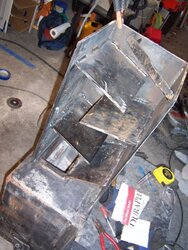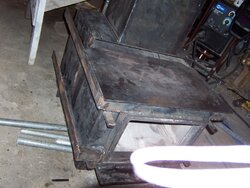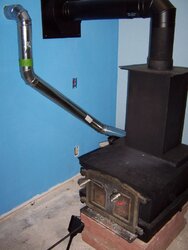Yep, all the baffling creates a problem. Our only saving grace to making the system work at all is the tall insulated SS stack IMO.
Having thought about this with some of coaly's input, I think one of the problems here is simply not enough air inlet cross section on the stove itself to get into a nice self-sustaining mode with the doors shut.
It didn't help that a lot of our prior problems with buildup were probably related to our inability to force ourselves to have good stove use technique to begin with. Being new to the whole thing, we were trying to use it as a way to provide constant heat on a demand style basis, meaning... smaller loads, cooler burns, etc etc. Granted we INTENDED not to do this, but it is hard not to go over and poke at a new toy, and throw a log in once and awhile.
The last couple days, I have been trying to stick to a very strict regiment and things are definitely working better. When I build A fire, I build it with a very large pile of kindling, and a couple large logs under that to act as the grate (a mixed bag of upside-down build technique and log cabin/teepee/mess standard). I burn through most of that kindling very fast and hot with the door cracked and then, about 10-20 minutes after the kindling has been working, add as many larger pieces as I can fit in with loose stacking arrangement in order to keep air flow up, but also, maximize the use of the box space. After this load, I continue to leave the door cracked a bit, for about another 10-25 minutes (depending on how fast the fire wants to build due to variables). When the stove temp has reached about the peak I am looking for, most of the "clinking" sounds from the baffle contraption expanding will slow down and, around that time, the center top of the stove may have a very slight incandescent glow if viewed with the lights completely off and blocking your eyes from the light of the fire. At that point I close the doors, but leave the damper full open (don't even have a damper on the exhaust, only on the intake).
After doing that, the best thing I can do for the stove seems to be to leave it alone. Allow the burn cycle to commence unattended and undisturbed, under the natural amount of dampening we have in place as a result of the mods. The center top of the stove will stay some-what steady leaning towards a decline in temps steadily for about an hour or more at this point, running very hot, but not getting any hotter. The exhaust goes clear, and the stove provides a couple hours of very high heat output, followed by 2-3 hours of diminishing heat as the fire is reduced to coals and most of the coals quiet down towards the end. After about 4-5 hours from when the initial fire was started, I can rake coals forward into a pile. The blast effect of air gets them excited again, and this provides a continuation of lower heat output for about another hour or so. At which point, it's either time to let it die completely (if it's day time then and not enough heat demand to call for another cycle), or a pile of kindling and large pieces and start all over again.
This endeavor has me wondering about rocket stove designs. I've done a lot of research on them. I realize this forum doesn't really seem to placate to them. I suspect they probably have a lot of problems that are not very well disclosed by all the burlap sack folks pushing them on youtube. That said, I have to admit that with our particular stove design, I have found that I can get a much cleaner burn, earlier in the burn, if I use the stove in a more "rocket stove" manner.. In that, rather than loading new fuel on top of coals at the front of the stove, if after utilizing those coals a bit at the front, I then move them to the BACK, then load fuel, the result is a remarkably clean burning "self fueling" fire that works it's way against the flow of air though the stove. The wood stacked in the stove acts as a series of "jets" to fuel the fire in the back of the stove with "forced" air. The baffle system heats up very fast this way, the exhaust then is almost entirely steam even early on once a "fire" is going. This sort of burning method would never be a good idea in a stove of this design if it drafted directly into a regular stove pipe (would probably melt the pipe), however, it works pretty well in this stove design, and when the cap is clean, the drafting effort is more than enough to make a deep "roaring" sound as the air feeds the intense fire. I think I am going to make a point of building fires "backwards" more often now as well in this stove. I think it's the key to making it work right. I realize that giving the stove air through the door to burn properly at certain times is generally considered a big "no-no" in stoves, however, I have to imagine that in our case, doing so is not counterproductive as it is in the case of most stove designs, since- sending more heat/air up the back of the stove, simply means that we will heat that baffle system up more, which can move that heat to the house. In fact, we "HAVE" to put more heat up the back of the unit if we want enough EGTs to keep the chimney clean.
Thank you all for the constructive and useful critiquing and information. This is a great forum, lots of great people here.
Thanks,
Eric





